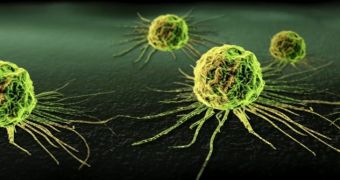Not too long ago, a team of researchers used a bacterium to successfully shrink tumors in rats, dogs, and even a human patient. The experiments are detailed in a paper published in yesterday's issue of the journal Science Translational Medicine.
As explained by Medical Express, these experiments were carried out by scientists with the Johns Hopkins Kimmel Cancer Center in the US. Their outcome brings new hope to cancer sufferers.
Writing in the journal Science Translational Medicine, the scientists explain that the bacterium they got to toy with while working on this research project goes by the name of Clostridium novyi. Still, some like to call it C. noyvi-NT.
This microorganism is commonly found in soils. What's interesting is that, according to previous investigations, it's not exactly the friendliest little fellow on the block. On the contrary, it can cause tissue-damaging infections.
Hence the fact that, in order to use it to shrink tumors in living organisms, the Johns Hopkins Kimmel Cancer Center scientists first had to toy with its genetic makeup. More precisely, the researchers had to get rid of one of its toxin-producing genes.
Having made the bacterium safe for therapeutic use, specialists first injected it into laboratory mice. Later, they exposed 16 pet dogs to it. All of these pooches were being treated for naturally occurring tumors at the time the experiments were carried out.
Of the dogs that were injected with the bacterium, three experienced a drop of about 30% in the length of the bulkiest part of their tumors. Another three managed to shake off their tumors completely. On the downside, nearly all the dogs experienced side effects such as fever and inflammation.
Later on, the bacterium was introduced into the body of a patient who had a metastatic tumor in one of her arms. The bacterium was injected straight into the mass of abnormal tissues, and caused the tumor to shrink to a considerable extent. The woman experienced the same side effects displayed by the dogs.
Fever, abscesses, and inflammation aside, the researchers say that they are quite pleased with the outcome of this series of experiments, and that their work could one day lead to the development of more effective treatments for various forms of cancer.
“One advantage of using bacteria to treat cancer is that you can modify these bacteria relatively easily, to equip them with other therapeutic agents, or make them less toxic as we have done here,” explained Shibin Zhou, M.D., Ph.D., associate professor of oncology at the Cancer Center.

 14 DAY TRIAL //
14 DAY TRIAL //